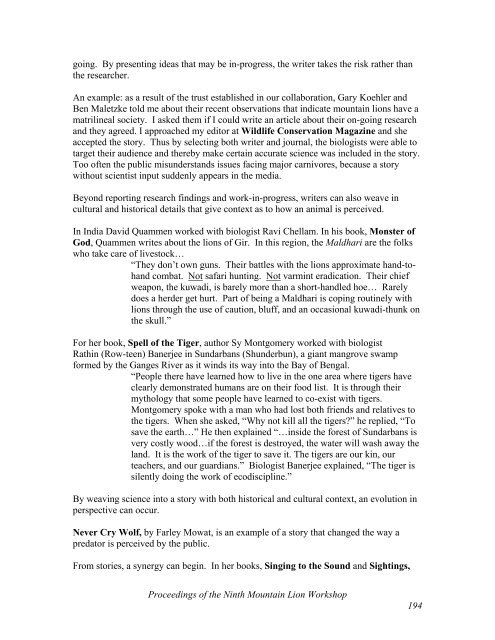Proceedings of the Ninth Mountain Lion Workshop - Carnivore ...
Proceedings of the Ninth Mountain Lion Workshop - Carnivore ...
Proceedings of the Ninth Mountain Lion Workshop - Carnivore ...
You also want an ePaper? Increase the reach of your titles
YUMPU automatically turns print PDFs into web optimized ePapers that Google loves.
going. By presenting ideas that may be in-progress, <strong>the</strong> writer takes <strong>the</strong> risk ra<strong>the</strong>r than<br />
<strong>the</strong> researcher.<br />
An example: as a result <strong>of</strong> <strong>the</strong> trust established in our collaboration, Gary Koehler and<br />
Ben Maletzke told me about <strong>the</strong>ir recent observations that indicate mountain lions have a<br />
matrilineal society. I asked <strong>the</strong>m if I could write an article about <strong>the</strong>ir on-going research<br />
and <strong>the</strong>y agreed. I approached my editor at Wildlife Conservation Magazine and she<br />
accepted <strong>the</strong> story. Thus by selecting both writer and journal, <strong>the</strong> biologists were able to<br />
target <strong>the</strong>ir audience and <strong>the</strong>reby make certain accurate science was included in <strong>the</strong> story.<br />
Too <strong>of</strong>ten <strong>the</strong> public misunderstands issues facing major carnivores, because a story<br />
without scientist input suddenly appears in <strong>the</strong> media.<br />
Beyond reporting research findings and work-in-progress, writers can also weave in<br />
cultural and historical details that give context as to how an animal is perceived.<br />
In India David Quammen worked with biologist Ravi Chellam. In his book, Monster <strong>of</strong><br />
God, Quammen writes about <strong>the</strong> lions <strong>of</strong> Gir. In this region, <strong>the</strong> Maldhari are <strong>the</strong> folks<br />
who take care <strong>of</strong> livestock…<br />
“They don’t own guns. Their battles with <strong>the</strong> lions approximate hand-tohand<br />
combat. Not safari hunting. Not varmint eradication. Their chief<br />
weapon, <strong>the</strong> kuwadi, is barely more than a short-handled hoe… Rarely<br />
does a herder get hurt. Part <strong>of</strong> being a Maldhari is coping routinely with<br />
lions through <strong>the</strong> use <strong>of</strong> caution, bluff, and an occasional kuwadi-thunk on<br />
<strong>the</strong> skull.”<br />
For her book, Spell <strong>of</strong> <strong>the</strong> Tiger, author Sy Montgomery worked with biologist<br />
Rathin (Row-teen) Banerjee in Sundarbans (Shunderbun), a giant mangrove swamp<br />
formed by <strong>the</strong> Ganges River as it winds its way into <strong>the</strong> Bay <strong>of</strong> Bengal.<br />
“People <strong>the</strong>re have learned how to live in <strong>the</strong> one area where tigers have<br />
clearly demonstrated humans are on <strong>the</strong>ir food list. It is through <strong>the</strong>ir<br />
mythology that some people have learned to co-exist with tigers.<br />
Montgomery spoke with a man who had lost both friends and relatives to<br />
<strong>the</strong> tigers. When she asked, “Why not kill all <strong>the</strong> tigers?” he replied, “To<br />
save <strong>the</strong> earth…” He <strong>the</strong>n explained “…inside <strong>the</strong> forest <strong>of</strong> Sundarbans is<br />
very costly wood…if <strong>the</strong> forest is destroyed, <strong>the</strong> water will wash away <strong>the</strong><br />
land. It is <strong>the</strong> work <strong>of</strong> <strong>the</strong> tiger to save it. The tigers are our kin, our<br />
teachers, and our guardians.” Biologist Banerjee explained, “The tiger is<br />
silently doing <strong>the</strong> work <strong>of</strong> ecodiscipline.”<br />
By weaving science into a story with both historical and cultural context, an evolution in<br />
perspective can occur.<br />
Never Cry Wolf, by Farley Mowat, is an example <strong>of</strong> a story that changed <strong>the</strong> way a<br />
predator is perceived by <strong>the</strong> public.<br />
From stories, a synergy can begin. In her books, Singing to <strong>the</strong> Sound and Sightings,<br />
<strong>Proceedings</strong> <strong>of</strong> <strong>the</strong> <strong>Ninth</strong> <strong>Mountain</strong> <strong>Lion</strong> <strong>Workshop</strong><br />
194
















